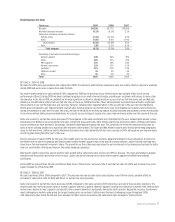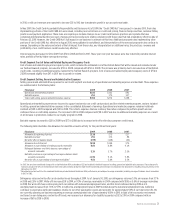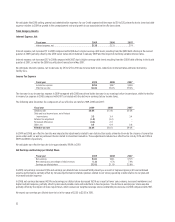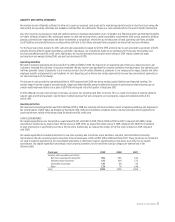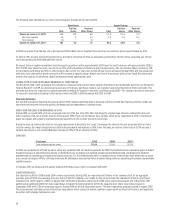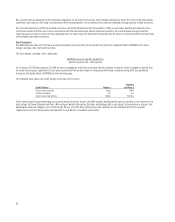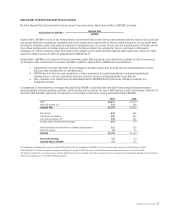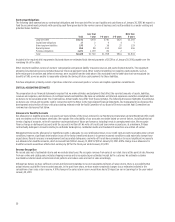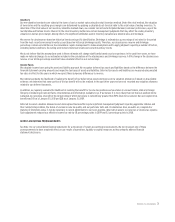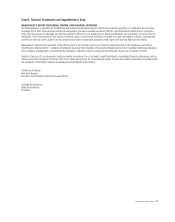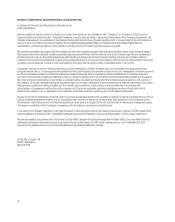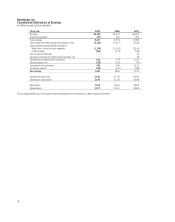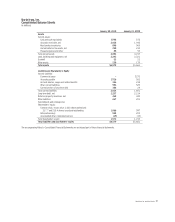Nordstrom 2009 Annual Report Download - page 35
Download and view the complete annual report
Please find page 35 of the 2009 Nordstrom annual report below. You can navigate through the pages in the report by either clicking on the pages listed below, or by using the keyword search tool below to find specific information within the annual report.
Nordstrom, Inc. and subsidiaries 27
Free Cash Flow (Non-GAAP financial measure)
We define Free Cash Flow as:
Free Cash Flow = Net Cash Provided By Operating Activities – Capital Expenditures – Change in Credit Card Receivables Originated at Third
Parties – Cash Dividends Paid + Increase in Cash Book Overdrafts
Free cash flow is one of our key liquidity measures, and we believe that our cash levels are more appropriately analyzed using this measure. Free cash
flow is not a measure of liquidity under GAAP and should not be considered a substitute for operating cash flows as determined in accordance with
GAAP. In addition, free cash flow does have limitations:
x Free cash flow does not necessarily represent funds available for discretionary use and is not necessarily a measure of our ability to
fund our cash needs; and
x Other companies in our industry may calculate free cash flow differently than we do, limiting its usefulness as a comparative measure.
To compensate for these limitations, we analyze free cash flow in conjunction with other GAAP financial and performance measures impacting liquidity,
including operating cash flows. The closest GAAP measure is net cash provided by operating activities, which was $1,251 and $848 for the 12 months
ended January 30, 2010 and January 31, 2009. The following is a reconciliation of our net cash provided by operating activities and free cash flow:
Fiscal year
2009 2008
Net cash provided by operating activities $1,251 $848
Less: Capital expenditures (360) (563)
Change in credit card receivables originated at third parties (182) (232)
Cash dividends paid (139) (138)
Add: Increase in cash book overdrafts 9 20
Free Cash Flow $579 $(65)
Net cash used in investing activities $(541) $(792)
Net cash provided by (used in) financing activities $13 $(342)
Credit Capacity and Commitments
As of January 30, 2010, we had total short-term borrowing capacity available for general corporate purposes of $950. Of the total capacity, we had
$650 under our commercial paper program, which is backed by our unsecured revolving credit facility and $300 under our Variable Funding Note
facility (“2007-A VFN”).
During 2009, we entered into a new unsecured revolving credit facility (the “revolver”) with a capacity of $650. This revolver replaced our previously
existing $650 unsecured line of credit, which was scheduled to expire in November 2010. The revolver, which expires in August 2012, is available for
working capital, capital expenditures and general corporate purposes. Under the terms of the agreement, we pay a variable rate of interest and a
facility fee based on our debt rating. Under the revolver we have the option to increase the revolving commitment by up to $100, to a total of $750,
provided that we obtain written consent from the lenders who choose to increase their commitment.
Our $650 commercial paper program allows us to use the proceeds to fund share repurchases as well as operating cash requirements. Under the terms
of the commercial paper agreement, we pay a rate of interest based on, among other factors, the maturity of the issuance and market conditions.
The issuance of commercial paper has the effect, while it is outstanding, of reducing borrowing capacity under our revolver by an amount equal to the
principal amount of commercial paper. As of January 30, 2010 we had no outstanding issuances under our $650 commercial paper program and no
outstanding borrowings under our revolver.
During 2009, we renewed our 2007-A VFN. The 2007-A VFN has a capacity of $300 and matures in January 2011. The 2007-A VFN is backed by
substantially all of the Nordstrom private label card receivables and a 90% interest in the co-branded Nordstrom VISA credit card receivables.
Borrowings under the 2007-A VFN incur interest based upon the cost of commercial paper issued by a third-party bank conduit plus specified fees.
We pay a commitment fee for the notes based on the size of the commitment. Under the renewed 2007-A VFN, we have the option to reduce the total
capacity or, provided that written consent is obtained from each of the parties to the Note Purchase Agreement, the facility contains the option to
increase the total capacity. As of January 30, 2010, we had no outstanding issuances against this facility.
Our wholly owned federal savings bank, Nordstrom fsb, also maintains a variable funding facility with a short-term credit capacity of $100. This facility
is backed by the remaining 10% interest in the Nordstrom VISA credit card receivables and is available, if needed, to provide liquidity support to
Nordstrom fsb. At the end of 2009 and 2008, Nordstrom fsb had no outstanding borrowings under this facility. Borrowings under the facility incur
interest based upon the cost of commercial paper issued by the third-party bank conduit plus specified fees.
We maintain import and standby letters of credit to facilitate international payments. As of January 30, 2010, we have $10 available under an import
letter of credit, with $5 outstanding. We additionally hold a $15 standby letter of credit, with $12 outstanding under this facility at the end of the year.


